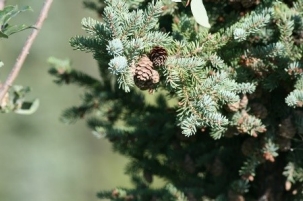O'so:ra (spruce) / White spruce (Picea glauca; Épinette blanche) is a native conifer that ranges across Canada (Government of Canada, 2015) (USDA Plants Database, n.d.). It even grows up to the Arctic tree line, where it is the upper northern limit of where trees can grow (Government of Canada, 2015).
Traditional uses of O'so:ra included making frames for snowshoes, glue, and medicines. The young tips can be eaten.
The name Picea glauca comes from the foliage, which looks a bit glaucous (a dull waxy whiter green) (Missouri Botanical Garden, n.d.). While this could be an identification tip, the Spruce is more likely to be identified by the aromatic (or pungent for some) scent when the needles are crushed (Government of Canada, 2015) (Missouri Botanical Garden, n.d.). The Spruces can also be identified by their conical, irregular crown and, most of all, by the fact that their needles are square when rolled between the thumb and forefinger and come off the twigs individually (unlike many pines) and from all directions (unlike the firs).
The White spruce is planted for reforestation and landscaping but is also used for lumber and pulp and paper. It is therefore an important commercial species in Canada (Government of Canada, 2015) (Nesom, 2003). In addition, the seeds stored in the cones are sources of food and the foliage provides shelter for many animals.
White spruce is not the most commonly planted tree in the city but there are still over 3000 among the public trees of Montreal (Quebec Centre for Biodiversity Science, 2023). Most of the White spruce trees on campus are quite small, planted as part of the effort to increase canopy cover and especially the diversity of native trees on campus in the fall of 2019.
References
- Government of Canada, Natural Resources Canada. (2015, August 4). White spruce. Government of Canada, Natural Resources Canada. Retrieved April 15, 2023, https://tidcf.nrcan.gc.ca/en/trees/factsheet/38
- Missouri Botanical Garden. (n.d.). Picea glauca - Plant Finder. Missouri Botanical Garden Retrieved April 15, 2023, from https://www.missouribotanicalgarden.org/PlantFinder/PlantFinderDetails.aspx?taxonid=284990
- Nesom, G.. (2003 February 13). Plant Guide Picea glauca. USDA Plants Database United States Department of Agriculture Natural Resources Conservation Service. Retrieved April 08, 2023, from https://plants.usda.gov/DocumentLibrary/plantguide/pdf/pg_pigl.pdf
- Quebec Centre for Biodiversity Science (2023). Public trees of Montreal. https://www.quebio.ca/en.
- USDA Plants Database (By USDA NRCS National Plant Data Team.). (n.d.). Picea glauca. United States Department of Agriculture Natural Resources Conservation Service. Retrieved April 14, 2023, from https://plants.usda.gov/home/plantProfile?symbol=PIGL


 Branch of O'so:ra, White Spruce
Branch of O'so:ra, White Spruce